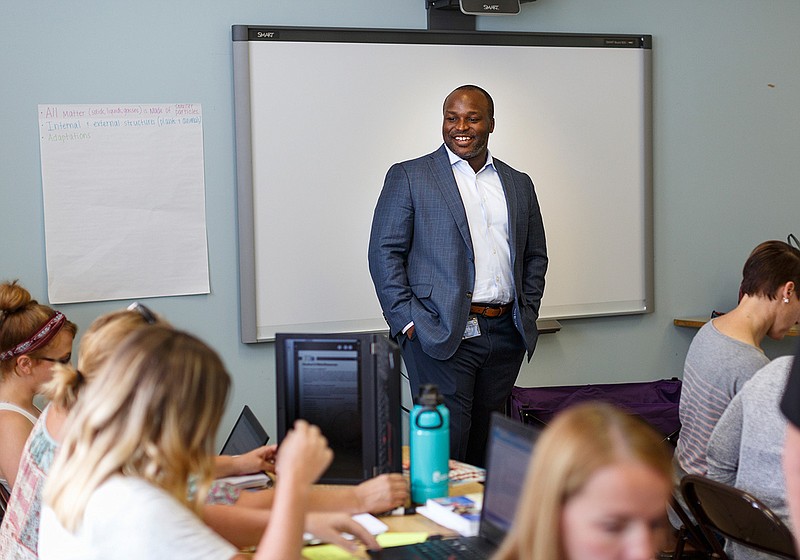When the Hamilton County Schools rolled out its Future Ready Institutes in March, the announcement came with disclaimers.
"The first year or two," Superintendent Dr. Bryan Johnson told Times Free Press editors and reporters at the time, "we might not meet our goals."
And, said Dr. Nakia Towns Edwards, the superintendent's chief of staff, "we may not have 100 percent transportation the first year."
They were talking about the rollout of the initiative, which is to potentially give students - beginning in the 2018-2019 school year - a leg up on a post-high school world through concentration in an industry or trade, and which could help increase diversity across the district.
The goal for the first year, officials had said, was 100 students in each of what turned out to be 20 institutes - 50 students from the home high school and 50 from out of the host school's zone.
The reality of the first week's enrollment, though, was somewhat underwhelming.
As of Monday, 1,288 high school students had enrolled in the institutes out of a potential 2,000. But only about 70 students of those 1,288 - about 5.4 percent - came from out of zone.
District officials said in March they hoped to have some of the transportation solutions for out-of-zone students in place by the time school started. Indeed, in a frequently asked questions sheet for parents, the district said, "To provide limited, sustainable transportation options, Hamilton County Schools will establish bus transportation partnerships to be shared by mid-April in advance of parent informational meetings."
Apparently, though, no transportation options for out-of-zone students materialized. And officials already have admitted they are aware of some students who would have attended one of the institutes had there been transportation available.
That is disappointing, but it's no reason to give up a good concept.
Johnson and school officials, with the institutes located in various schools, were trying to help solve two crises - one real and one felt.
The real crisis is the number of students who graduate who do not go to college and do not seek any marketable credential. Meanwhile, industry and business in the area continue to grow living wage jobs but, increasingly, cannot find qualified employees to fill them.
In time, if such employers cannot find enough skilled labor, they would be foolish not to look to move elsewhere. That's a lose-lose situation for the students and the area and one we should not let happen.
The felt crisis is one in which certain groups have complained that the district's schools are still not as racially diverse as they should be and certainly not as economically diverse as they want them to be.
In the Hamilton County Schools district, as of 2016, 32 schools were either 90 percent or more white or 90 percent or more non-white, meaning about 47 schools were more racially mixed. Lower-income households were more frequently concentrated in the school districts with more than 90 percent non-white students.
For all schools to be more racially integrated, officials can repeat the federal mistakes of the early 1970s and require forced busing. That's not likely to happen. They can redraw district zones, which is likely to happen but not necessarily soon, and won't make a dramatic difference. Or they can create more true magnet schools like the successful Chattanooga School for the Arts and Sciences and Chattanooga School for the Liberal Arts, and offer the Future Ready Institutes in a diverse variety of high schools.
The problem in each of the scenarios, to some extent, is transportation, on which the district already spends millions of dollars.
"In a perfect world, you are able to provide transportation to all students," Johnson told the Times Free Press last week. "You also understand there are budgetary challenges."
Unless other solutions are forthcoming, out-of-zone parents will provide transportation for their students to attend the Future Ready Institute of their choice during the 2018-2019 school year. If the program is to be successful, some type of transportation system involving additional bus routes, a transportation hub or CARTA buses will need to happen for the 2019-2020 school year.
District officials, meanwhile, had hoped students would follow the "Field of Dreams" mantra: If you build it, they will come.
In fact, some did. The Institutes of International Baccalaureate Studies, which already had been in place at Ooltewah and Signal Mountain high schools, are full. The Institute of Building and Design at East Ridge, which also had been in place, is more than full. The Institute for Health Careers and Medical Advancement at Hixson High School and the Institute of Hospitality and Tourism at The Howard School are full. The Institute of Start-Ups and Web Design at Soddy-Daisy has 71 students, and the Institute for Integrative Agriculture, Food and Natural Resources at Hixson High School has 64.
The disappointing lack of transportation aside, the idea for the Future Ready Institutes is the type of out-of-the-box thinking that has been needed in the district. For Chattanooga and Hamilton County to be more successful, grades, educational consistency and job readiness all must improve. We are still confident this can be a good start.
